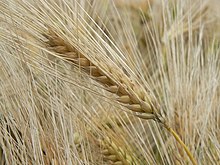| 意味 | 例文 (1件) |
hummelとは 意味・読み方・使い方
追加できません
(登録数上限)
意味・対訳 ハメル
「hummel」を含む例文一覧
該当件数 : 1件
-
履歴機能
 過去に調べた
過去に調べた
単語を確認! -
語彙力診断
 診断回数が
診断回数が
増える! -
マイ単語帳
 便利な
便利な
学習機能付き! -
マイ例文帳
 文章で
文章で
単語を理解! -

Wiktionary英語版での「hummel」の意味 |
hummel
語源

Probably from Middle English hamelen (“to maim, mutilate; to cut short”), from 古期英語 hamelian (“to hamstring, mutilate”),[1][2] from Proto-Germanic *hamalōną, *hamlōną (“to mutilate”), from Proto-Indo-European *kem- (“hornless; mutilated”). Cognate with Dutch hamel (“wether”), English hamble, Low German hommel, hummel (“an animal lacking horns”),[3] humlich, dialectal hommlich (“lacking horns”), Bavarian humlet (“lacking horns”),[4] German hammeln, hämmeln (“to geld”), Icelandic hamla (“to maim, mutilate”).
OxfordDictionaries.com suggests that the “ear of grain with its awns removed” sense preceded the “animal without antlers or horns” sense.[3]
名詞
hummel (複数形 hummels)
- (Northern England, Scotland, also attributive) A stag that has failed to grow antlers; a cow that has not developed horns. [from late 15th c.]
- 1850 January, “[Quarterly Summary of the Improvements and Discoveries in the Medical Sciences. Anatomy and Physiology.] On the Fœtus in Utero, as Inoculating the Maternal with the Peculiarities of the Paternal Organism; and on the Influence thereby Exerted by the Male on the Constitution and the Reproductive Powers of the Female. By Alexander Harvey, M.D. (Monthly Journ. of Med. Sciences, Oct. 1849.)”, in Isaac Hays, editor, The American Journal of the Medical Sciences, volume XIX (New Series), number XXXVII, Philadelphia, Pa.: Lea & Blanchard; London: John Wiley, and John Miller, OCLC 863165171, page 180:
- 1872 February, “An Old Mountaineer” [pseudonym], “Deer-stalking in the Highlands”, in Baily’s Monthly Magazine of Sports and Pastimes, volume XXI, number 144, London: A. H. Baily & Co., OCLC 614992700, page 233:
- A little hillock gave me ample concealment and an excellent rest for my rifle; and there I reposed as hinds and little stags filed by. First came the wary old hind, looking sharply about her; then a little stag, indifferent to consequences; then more hinds and calves; and last of all the great hummel. As he landed on top of the brow, about fifty yards from me, he stopped to look around. I drew a bead on the junction of his neck and shoulder, pressed gently on the trigger; a bang—smack, followed, and the great hummel lay stretched upon the heather.
- 1898, J. E. Harting, “RED DEER—(Cervus elaphus)”, in the Earl of Suffolk and Berkshire [Henry Charles Howard, 18th Earl of Suffolk and 11th Earl of Berkshire], Hedley Peek, and F. G. Aflalo, editors, The Encyclopædia of Sport, volume II, London: Lawrence and Bullen, Ltd. 16 Henrietta Street, Covent Garden, page 248:
- Hornless Stags are not unknown, especially in the German forests. By this expression is meant, not stags wich have once carried antlers and shed them, but stags which have never possessed any. In the Highlands they are termed hummel stags; […] Haviers, or stags which have been gelded when young, have no horns, as is well known, and in the early part of the stalking season, when seen through a glass, might be mistaken for hummels; but as the season advances, the necks of the latter swell, and (except in the matter of horns) they assume all the characteristics, both in appearance and behaviour, of ordinary stags, and are thus easily distinguished from haviers.
- 2005, Brian K[eith] Hall, “Antlers”, in Bones and Cartilage: Developmental and Evolutionary Skeletal Biology, San Diego, Calif.; London: Elsevier Academic Press, →ISBN, page 107, column 1:
- Regeneration in the animal kingdom always requires a wound stimulus. Regrowth of antlers is no exception, the wounded pedicle exposed by the casting of the previous set of antlers serving as a vital stimulus for renewal of antler growth. This was convincingly demonstrated in congenitally polled (‘hummel’) red deer, which lack antlers, have pedicles, and can be induced to form a set of antlers if the tips of the pedicles are amputated.
- 2013, Steven P. Ashby, “Some Comments on the Identification of Cervid Species in Worked Antler”, in Alice Choyke and Sonia O'Connor, editors, From These Bare Bones: Raw Materials and the Study of Worked Osseous Objects: Proceedings of the Raw Materials Session at the 11th ICAZ Conference, Paris, 2010, Oxford; Oakville, Conn.: Oxbow Books, →ISBN:
- Contrary to popular sporting belief […], it has also been postulated that the reason for the hummel’s lack of antlers is not genetic, but relates to poor nutrition in the early stage of life, and a consequent failure to grow pedicles […].
- (also attributive) Especially in hummel corn: grain that lacks awns (beards または bristles), or has had its awns removed (barley, oats, etc.).
- 1792, Robert Bowmaker, “Number LI. Parish of Dunse, (County of Berwick.)”, in John Sinclair, editor, The Statistical Account of Scotland. Drawn Up from the Communications of the Ministers of the Different Parishes, volume IV, Edinburgh: Printed and sold by William Creech [et al.], OCLC 499791781, page 386:
- [1808, John Jamieson, “Hummel-corn”, in An Etymological Dictionary of the Scottish Language: […] In Two Volumes, volume I (A–K) (in Scots), Edinburgh: […] University Press; for W[illiam] Creech, A[rchibald] Constable & Co., and W[illiam] Blackwood; London: Longman, Hurst, Rees, & Orme, T[homas] Cadell & W. Davies, and H. D. Symonds, OCLC 946611778:
- 1876, William Brockie, “Matrimony: A Puir Hynd’s Sorrowfu Soliloquy”, in The Confessional, and Other Poems, Sunderland: T. F. Brockie, 2, High Street East, OCLC 32337015, page 179:
別の表記
動詞
hummel (三人称単数 現在形 hummels, 現在分詞 hummelling, 過去形および過去分詞形 hummelled)
- (transitive) Of an animal: to remove the horns; to poll.
- (transitive) To separate (barley, oats, etc.) from the awns.
- 1812 August 5, “S.” [pseudonym], “A Cheap Method of Hummelling Barley”, in The Farmer’s Magazine: A Periodical Work Exclusively Devoted to Agriculture and Rural Affairs, volume XIII, number LII, Edinburgh: Printed by David Willison, for Archibald Constable and Company, Edinburgh; and Longman, Hurst, Rees, Orme and Brown, London, published 16 November 1812, OCLC 938136568, pages 443–444:
- From the minute description of the machinery, I am apt to think it is made at a considerable expense; [...] I am therefore induced to mention the manner of hummelling (または fattering, as it is called in this county) with me. [...] My thrashing mill is of the old construction, being the first erected in this county (excepting one on Cotterel's plan), and is very powerful; but I apprehend any machine has power enough for the hummelling work.
- 1814, Robert Kerr, “On the Management of Arable Land in Scotland”, in General Report of the Agricultural State, and Political Circumstances, of Scotland. Drawn Up for the Consideration of the Board of Agriculture and Internal Improvement, under the Directions of the Right Hon. Sir John Sinclair, Bart. the President, volume I, Edinburgh: Printed by Abernethy & Walker, and sold by Arch[ibald] Constable & Co. Edinburgh; and Longman, Hurst, Rees, Orme & Brown, London, OCLC 561811697, part IV (Of the Articles Principally Cultivated for Their Seed), section III (Of Barley), page 498:
- [M]ost threshing-machines are defective in regard to separating the awns of barley from the grains, especially when it has been led home in a raw or soft state. Various devices are often had recourse to for obviating this defect. [...] In other cases, where either of these devices are wanting, it has to be hummelled on the barn-floor, either by means of threshing with the old flails or swiples, or by stamping it with an implement resembling a paviour's ram, the under end of which is armed with plate iron made like a honeycomb. On some occasions, barley has known to be too much hummelled, at least for the use of maltsters; as, when the awn breaks off so close as to leave a small portion of the kernel naked, such grains do not malt kindly.
- 1867, A. S. Wilson, “The Weight of Corn”, in Journal of the Bath and West of England Society for the Encouragement of Agriculture, Arts, Manufactures, and Commerce, volume XV, London: Published by W. Ridgway, 169, Piccadilly, sold by R. E. Peach, Bath; F. May, Taunton; W. Roberts, Exeter; James and James, Plymouth, OCLC 8621654, page 244:
- If threshed by the flail, the awns and sharp points [of oats] will be less broken and hummelled than if threshed by machinery. Whatever hummels the grain most will produce the heaviest bushel, while, of course, extremely little variation will have taken place in the dynamical relation of the kernel and hull.
- 1875, Edward H. Knight, “Hummeling-machine”, in Knight’s American Mechanical Dictionary: Being a Description of Tools, Instruments, Machines, Processes, and Engineering; History of Inventions; General Technological Vocabulary; and Digest of Mechanical Appliances in Science and the Arts, volume II (Ena–Pan), New York, N.Y.: J. B. Ford and Company, OCLC 950905381, page 1142, column 1:
別の表記
参照
- ^ Compare Abram Smythe Palmer (1876) , “The Words ‘Flirt’—‘Flunkey’—‘Scorn’”, in Leaves from a Word-hunter’s Note-book. Being Some Contributions to English Etymology, London: Trübner & Co., Ludgate Hill, OCLC 156094804, footnote 2, page 43: “The expression an 'humble' deer, an 'humble' ewe, is applied to one without horns; but this is a corruption of hummel'd, from prov[incial] Eng[lish] hummel, hammel, O[ld] N[orse] hamla, to mutilate, lop, A[nglo-]Sax[on] hamelan, to hamstring.”
- ^ A[bram] Smythe Palmer (1882) , “Humble”, in Folk-etymology: A Dictionary of Verbal Corruptions or Words Perverted in Form or Meaning, by False Derivation or Mistaken Analogy, London: George Bell & Sons, OCLC 1000034280, page 182, column 2:
- Humble, in the sense of hornless, applied to a cow, ewe, deer, &c. […], is a corrupt form of Scotch and Northern Eng. hummel, hummle, homyll, without horns; […] All these words are akin to Prov[incial] Eng[lish] hamel, to lame, Ger[man] hammel, a wether, A[nglo-]Sax[on] hamelian, Icel[andic] hamla, to maim or mutilate.
- ↑ 3.0 3.1 “hummel” in Lexico, Dictionary.com; Oxford University Press.
- ^ “hummel” in The Oxford English Dictionary, 2nd edition, Oxford: Clarendon Press, 1989, →ISBN.
Further reading
- hummel (disambiguation) on Wikipedia.
| 意味 | 例文 (1件) |
|
|
hummelのページの著作権
英和・和英辞典
情報提供元は
参加元一覧
にて確認できます。
| All Rights Reserved, Copyright © Japan Science and Technology Agency | |
| Copyright © 2025 CJKI. All Rights Reserved | |
|
Text is available under Creative Commons Attribution-ShareAlike (CC-BY-SA) and/or GNU Free Documentation License (GFDL). Weblio英和・和英辞典に掲載されている「Wiktionary英語版」の記事は、Wiktionaryのhummel (改訂履歴)の記事を複製、再配布したものにあたり、Creative Commons Attribution-ShareAlike (CC-BY-SA)もしくはGNU Free Documentation Licenseというライセンスの下で提供されています。 |
|
| CMUdict | CMUdict is Copyright (C) 1993-2008 by Carnegie Mellon University. |
ピン留めアイコンをクリックすると単語とその意味を画面の右側に残しておくことができます。 |
|
ログイン |
Weblio会員(無料)になると
|
「hummel」のお隣キーワード |
weblioのその他のサービス
|
ログイン |
Weblio会員(無料)になると
|

